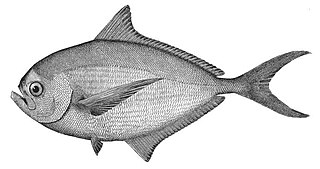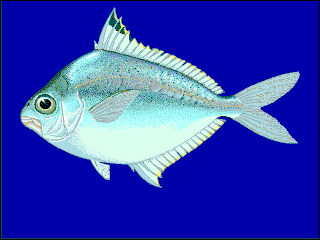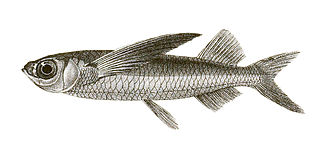
Hirundichthys is a genus of flying fish. They have elongated, moderately thick, ventrally flattened bodies. The pectoral branch of the lateral line is absent. The upper jaw is not protrusible. The dorsal fin has fewer or equal rays than the anal fin; the dorsal fin is low, with the anterior rays the longest, the pectoral fins are strikingly long, reaching to or almost to caudal fin base; pelvic fins are long, reaching beyond the anal fin origin, and their insertion is closer to the anal fin origin than to the pectoral fin insertion.

The rock beauty, also known as corn sugar, coshubba, rock beasty, catalineta, and yellow nanny,is a species of marine ray-finned fish, a marine angelfish belonging to the family Pomacanthidae. It is found in the western Atlantic Ocean.

The queen angelfish, also known as the blue angelfish, golden angelfish or yellow angelfish, is species of marine ray-finned fish, a marine angelfish belonging to the family Pomacanthidae. It is commonly found near reefs in the warmer sections of the western Atlantic Ocean.

Centropyge tibicen, the keyhole angelfish, black angelfish, whitespot angelfish or puller angelfish, is a species of marine ray-finned fish, a marine angelfish belonging to the family Pomacanthidae. It is found in the Indo-Pacific region.

The giant African threadfin is a species of ray-finned fish from the threadfin family Polynemidae. It is found in the eastern Atlantic Ocean off the west coast of Africa.

Polydactylus sexfilis, the six-finger threadfin or yellowthread threadfin, is a species of marine ray-finned fish, a threadfin from the family Polynemidae which is found in the Indian and Pacific Oceans.

The false scorpionfish, also known as prettyfins, is a species of perciform fish, the only species in genus Centrogenys, which in turn is the only genus in the family Centrogenyidae. They are pale grey or brown and usually grow no longer than 25 cm (9.8 in). False scorpionfish are distributed throughout the Indo-West Pacific, bounded by the Ryukyu Islands of Japan to the north and Australia to the south, the Nicobar Islands to the west and New Guinea to the east.

The Indian threadfin is a species of marine ray-finned fish from the family Polynemidae, the threadfins. It is a coastal species from south-east Asia which has been recorded in Papua New Guinea.

Chaetodon hoefleri, the four-banded butterflyfish, is a species of marine ray-finned fish, a butterflyfish from the family Chaetodontidae. It is native to the tropical eastern Atlantic and has been recorded in the Mediterranean.

Brama is a genus of marine ray-finned fishes from the family Bramidae, the pomfrets. Currently, there are 8 species within the genus.

Eubleekeria splendens, common names splendid ponyfish and blacktip ponyfish, is a species of ponyfish.

Selene setapinnis, the Atlantic moonfish, is a West Atlantic fish belonging to the family Carangidae.

Genicanthus melanospilos, the spotbreast angelfish, blackspot angelfish or swallowtail angelfish, the family Pomacanthidae. It occurs in the Indo-West Pacific region.

Polynemus multifilis, the elegant paradise fish is a species of ray-finned fish, a threadfin from the family Polynemidae which is found in rivers in southeast Asia.
Polynemus aquilonaris, commonly known as the northern paradise fish, is a fish of the threadfin family Polynemidae. It is native to the large rivers of mainland Southeast Asia.
The dwarf paradise fish, also known as the streamer threadfin or streamered tasselfish, is a species of ray-finned fish from a family Polynemidae, the threadfins. It is the only species in the genus Parapolynemus and it is found in Australia and New Guinea.

Parexocoetus mento; also known as the African sailfin flying fish, Cuvier's flying fish, the yellow belly flying fish or the short-winged flying fish; is a species of flying fish from the family Exocoetidae which is found in the Indo-pacific region and which has colonised the eastern Mediterranean.

Exocoetus obtusirostris, commonly known as the oceanic two-wing flyingfish or the blunt-snouted flyingfish, is a species of ray-finned fish native to the tropical and subtropical western Atlantic Ocean. It has the ability to glide above the surface of the water to escape from predators.

The threestripe gourami, also known as the Mekong croaking gourami, is a species of freshwater ray-finned fish from the subfamily Macropodusinae which is part of the gourami family Osphronemidae. It is native to south-east Asia.

The Clipperton angelfish is a species of marine ray-finned fish, a marine angelfish belonging to the family Pomacanthidae. It is endemic to Clipperton Island, a French possession in the eastern Pacific Ocean.




















